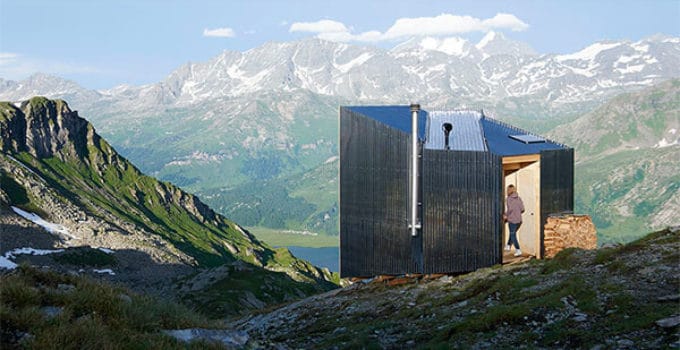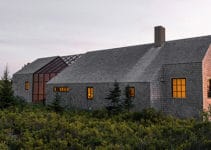Built high in the Swiss Alps by On as an overnight alpine hut for hikers and joggers, this little structure feels at home in the high mountain environment.
Located in Piz Lunghin, Switzerland, designed and produced by Swiss footwear Brand On in honor of the introduction of their Cloud series trail shoes, posted initially on Dezeen, this alpine hut is an excellent example of minimal design based on necessity.
On Alpine Hut
On’s mission in the creation of the alpine hut was to have zero impact on the landscape, generate electricity for lighting, and collect rainwater for guest use.
The structure sits on bedrock, is anchored by cables for the wind, equipped with a solar collector for low voltage lighting, and includes a roof detail in the design that collects and stores water.
A steep two-hour hike from the town of Maloja, near St. Moritz, leads to this remarkable alpine hut at 8202 feet (2500 meters) above sea level.


Cool Exterior
The design team at On chose reflective corrugated metal sheathing for the roof and the sides of the structure so that the building would blend into the surrounding landscape. Subsequently, the alpine hut merges nicely with the stone, grass, and sky and has a minimal visual impact on the site.



Alpine Lake
The alpine hut is located just above a small crystal clear alpine lake. This lake is free of ice only a short period of the year from mid-summer to early fall, and the bottom is visible at any depth.


Warm Interior
The building is constructed of insulated plywood panels that can be quickly built and deconstructed.
The interior has been left as unfinished plywood. The wood produces a warm and welcoming ambiance due to reflected natural light.
A built-in coat closet is adjacent to the entry door, a wood stove provides both heat and a place to cook or heat water, and the design team includes plywood furniture for dining.


Loft
A ladder leads to a sleeping loft with grand views in two directions and an operable window for natural ventilation.


Alpine Refuge
At night the low voltage lighting system warms the alpine hut to produce a safe and secure feeling for guests visiting this vast and inhospitable high mountain environment.
A few building attributes are necessary to make an alpine sleeping location feel less vulnerable to the natural elements.
The physical enclosure gives a feeling of protection from the wind, rain, and snow. LED lighting ensures visibility at night when necessary, and a wood stove provides warmth and hot food or drinks to warm the soul after a long day in the natural elements.


Little Giant
The design team creates an alpine hut based on user needs leading to a very minimal and appealing overall design. The structure is split into two levels-one for eating and one for sleeping. The little building is made with insulated plywood panels for easy construction/deconstruction and covered with reflective corrugated metal to help it blend with the natural landscape. The overall result of the design is an alpine hut at home in its natural environment and the perfect place for rest and reflection on making this project a Little Giant.
Alpine Hut Takeaways:
- Carve available space into subspaces both vertically and horizontally
- Light-colored wood produces warm reflected light
- Take advantage of exterior views to make small rooms feel much larger
- Keep the interior finish color/material palette small & not too busy
- Splash a dash of personality into the design such as the reflective exterior
Images posted initially on Dezeen.
Photography by Anne Lutz and Thomas Stöckli of On
Another Alpine Hut
Visit another alpine hut used for hot saunas.
YouTube
See a ONE MINUTE photo tour on YouTube for this project.




